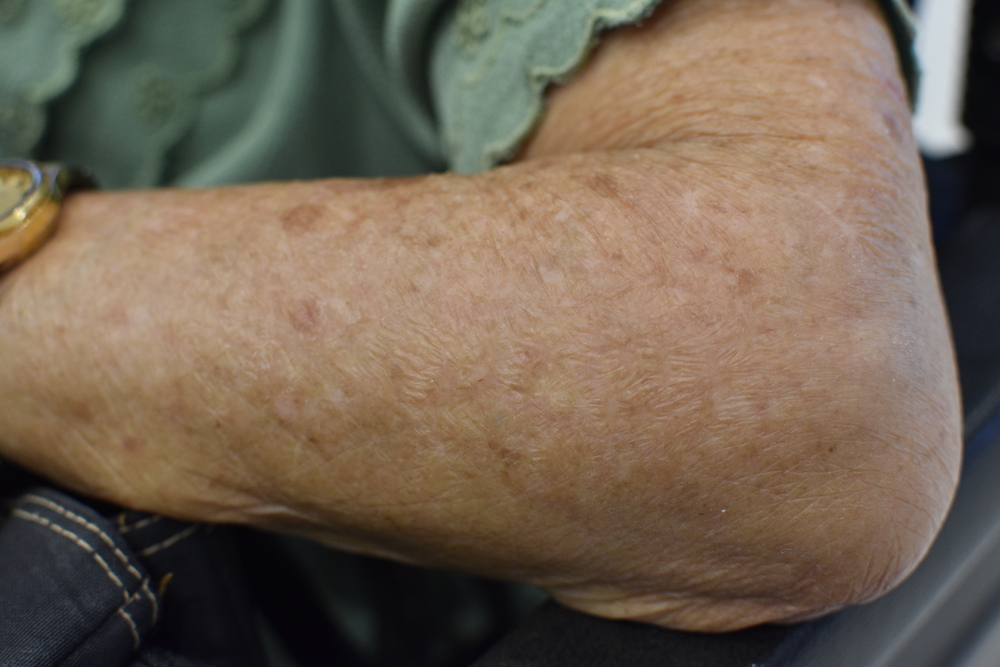- Professional and at-home exfoliating acid peels can help regenerate skin on the arms, legs, chest, and tummy.
- Although chemical body peels use the same skin-boosting acids as facial peels, they’re usually more concentrated.
- Body peels can be used to correct dryness, rough patches, uneven skin, wrinkles, and acne.
If you’ve tried chemical peels for the skin on your face — which is already smoother than the rough, scaly skin on your elbows, or knees — then you know it has the power to transform the dull and dry into the smooth and glowing.
It’s only natural that we should extend this peeling power to the rest of our body, right? Full body peels certainly bring the same amazing results as facial peels, but the product you put on your body is different from the stuff you put on your face.
What are Chemical Peels?
Let’s go back to the basics for a quick second. Acid peels work by causing the top layer of the skin to peel off, exposing the healthier layer beneath.
Essentially, it’s like exfoliation, but instead of manually sloughing away the dead skin cells though friction using micrograins or a rough surface, acids chemically exfoliate, leaving behind new skin without the scrubbing.
Even though the treatments are similar, treating the skin on our body is a bit different than treating the skin on our face. That’s because there is a whole other set of skin issues with the skin on our arms, legs, and décolletage. Plus, the skin on the body is usually dryer and thicker than the skin on our face.
So here’s what you need to know before you start your new full body peel regimen.
Chemical peels for arms and legs
Some of the most popular acid body peel options out there are designed to whip the skin on the legs and arms into shape. These kinds of skin peels are particularly useful for smoothing out sandpapery, wintery skin on the knees and elbows. They can also be used to even out sun damage and freckling, or smooth out chicken skin (keratosis pilaris) and other skincare concerns.
Even people with sensitive skin tend to tolerate acid peels on the arms and legs better than they might on the face. That’s because, of course, the skin on those parts of the body is usually thicker and less irritable.
Nevertheless, it’s important to first consult with a skincare professional if you have particularly oily, sensitive or dry skin and are considering this type of peel.
Choosing the best acid body peel for your skin issues
Just like a facial chemical peel, a body acid peel should be carefully selected based on a wide variety of factors. Different types of peels use different types of acids, and these acids are not all appropriate for all skin types, skin conditions, or body parts.
For these reasons, we highly recommend visiting a board-certified dermatologist or aesthetician for your treatment. Although many over-the-counter body peels are effective, you won’t see the same results after several months as you would with a single treatment administered by a professional.
There are some products that are proven to be safe and effective for at-home use, such as the StackedSkincare TCA Multi-Acid Body Peel. However, this treatment also claims to even out dark spots, which means that it could cause discoloration.
If you’re going to buy any kind of body peel online or in a store, make sure to read deep into the peel’s reviews, and do research on every ingredient.
If you read through the suggestions below, you’ll notice that body peels employ the same tried-and-true acid compounds that we use on our faces. Oftentimes, a professional might recommend a lower acid percentage on the face than the body, since the facial skin tends to be thinner and more delicate.
Due to its thick skin, the human body can handle higher concentrations of acid, and might require these high levels for the best results. Getting the percentage of acid just right is another reason why seeing a professional is so important. High-percentage peels can seriously damage or burn the skin permanently when improperly used.
Rough, scaly skin
Keeping the skin on our knees, elbows, and hands silky-soft is a special kind of challenge. Experts recommend the trichloroacetic (TCA) peel and peels with alpha hydroxy acids (AHA) for treating rough or scaly skin. If you’ve developed stubborn bumps and marks in your bikini area after years of shaving, a peel with lactic acid — a crucial part of the so-called “bikini facial” — can help to smooth the area.
Body acne
Body acne, sometimes called bacne, can cause frustrating and embarrassing blemishes that may even lead to scars that compromise your picture-perfect skin. A back peel packed with salicylic acid may be just what you need to clear away the pimples.
As you may know, this acid works wonders on acne because it unclogs pores and gets rid of pimple-causing dead cells. Body acne can also be treated with peels enriched with glycolic acid, which is similar to salicylic acid in that its greatest power is unclogging pores.
Chest wrinkles
The thin crepey skin on the chest is a prime locale for fine lines and wrinkles. Too many years of sun exposure leave skin fragile, dry, and droopy. The key to soft, elastic skin at the décolletage is to use a high-quality body lotion alongside the occasional salicylic or glycolic acid peel.
Glycolic acid is generally recommended for smoothing wrinkles and is safe for most patients, regardless of their skin tone or sensitivity level.
To brighten dull skin on the chest — or anywhere else on the body, for that matter — choose an alpha beta peel that will leave behind a bright, healthy glow.
Stretch marks
There are so many stretch mark treatments out there that it can be hard to sort out what works and what doesn’t.
While chemical peels won’t erase your stretch marks — you’ll want to consider abdominoplasty, tummy tuck, microneedling, or laser treatments for that — they will help to smooth out your skin and make some discoloration less noticeable.
Dark spots
If you’ve got dark marks on your body — especially dark knees or sun spots on your arms, legs, or back — a chemical peel can certainly provide a fix. As you probably know, some acid peels have a lightening effect and can be used to even out dark spots on the body.
Choose a chemical peel with hydroquinone for treating melasma, age spots, liver spots, and dark elbows and knees. Those with darker skin tones should only use hydroquinone skin peels when skin lightening is desired.
Take a full-body chemical peel with these aids
If you want to do a body chemical peel at home, these at-home peels and gels can help with acne, wrinkles, and other skin conditions.
Dr.G Brightening Peeling Gel
Gently exfoliates your old dead skin cells along with vitamin C and E brightening properties. Contains natural moisture-rich cellulose that keeps your skin moisturized and improves radiance. Regular use of this peeling gel can give you a clean and bright skin tone.
Mineral Peel Body – Flash Exfoliating Peel Spray
The non-abrasive composition is gentle but effective in removing dead skin cells without irritating the skin. Organic enzymes help promote new cell renewal. Moisturizing nutrients hydrate the skin and make you feel like a baby. Jojoba Oil, Grapefruit Seed, and Mugwort Extract are included to give you soft and supple skin.
Mizon Vita Lemon Peeling Gel
A great exfoliating treatment that unclogs pores and removes dead skin cells for a more youthful, radiant appearance. The moisturizing sparkling peeling gel helps restore the vibrancy and vitality of dull skin by eliminating dead skin cells with tangible moisturizing sparkling water. The mineral-rich French sparkling water helps to detoxify the skin with a no-pressure hydrating massage, leaving you with clear skin.
Skin Beauty Solutions – Glycolic Acid 70% Skin Chemical Peel
Glycolic acid peels are made from alpha-hydroxy acids (AHA), which are naturally occurring fruit sugar acids that gently peel and exfoliate the outermost layers of your skin, removing dead and damaged cells, stimulating and generating new skin cells, and boosting collagen production, which gives skin the strength it needs to stay looking young.
Glycolic acid peels can help you with a variety of skin problems, including hydrating dry skin, removing discoloration and age spots, healing scars, reducing fine lines and wrinkles, and exfoliating dead skin cells to allow new ones to form. Get young, rejuvenated, and glowing new skin with this chemical peel.
The Body Shop – Drops of Youth Liquid Peel
The Drops of Youth Liquid Peel gently exfoliates and scrapes away impurities from your skin while lifting dead skin cells and residuals. This breakthrough gel to peel is infused with a blend of three plant stem cells, leaving skin clean and purified from the pollutants. With continued usage, your skin will appear fresher, smoother, and more radiant.
What are the potential risks?
There are countless myths and misconceptions floating around about chemical peels, particularly with respect to who can get them.
While it’s true certain peels cause hyperpigmentation, there are several safe and effective options that can be used by people with darker skin tones. As you may know, chemical peels are typically categorized from light to deep. Those with darker skin tones should use light to medium peels and TCA peels as they provide the lowest risk of causing discoloration.
What about those of us with sensitive skin? Regardless of your skin tone, if you are prone to irritation you’re most likely better off sticking with lighter peels — those that use a lower percentage of glycolic acid, salicylic acid, lactic acid, and TCA.
In general, patients who have active skin infections, unusual scar formations, or certain skin disorders may need to consider other treatments. That said, even people with particularly sensitive skin may see some relief with the help of a board-certified dermatologist.














